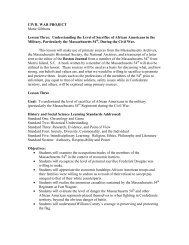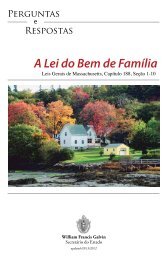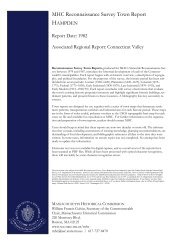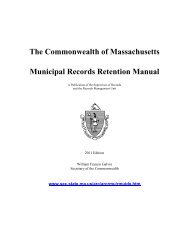Roads, Rails, and Trails - Secretary of the Commonwealth
Roads, Rails, and Trails - Secretary of the Commonwealth
Roads, Rails, and Trails - Secretary of the Commonwealth
Create successful ePaper yourself
Turn your PDF publications into a flip-book with our unique Google optimized e-Paper software.
Food remains from <strong>the</strong> site included bones <strong>of</strong> mammals<br />
(muskrat, deer, bear, beaver, <strong>and</strong> skunk), reptiles (snake <strong>and</strong><br />
turtle), birds <strong>and</strong> fish, shells <strong>of</strong> freshwater mussels, <strong>and</strong> charred<br />
pieces <strong>of</strong> hickory nut shell. These reflected <strong>the</strong> wide range <strong>of</strong><br />
environments accessible from <strong>the</strong> site: forested hills, wooded<br />
swamps, open rivers, ponds, <strong>and</strong> marshes, where people could<br />
hunt, fish, <strong>and</strong> ga<strong>the</strong>r.<br />
Even though it was small, <strong>the</strong> Hartford Avenue<br />
rockshelter was a place where people stayed at least now <strong>and</strong><br />
<strong>the</strong>n for many thous<strong>and</strong>s <strong>of</strong> years. There were artifacts from <strong>the</strong><br />
site’s deepest deposits that were as much as 7,000 years old.<br />
One feature inside <strong>the</strong> shelter (Feature 6) was much more<br />
recent than that; it was radiocarbon dated to sometime in <strong>the</strong><br />
13 th Century AD. This feature was particularly well preserved<br />
because part <strong>of</strong> it was protected from recent disturbance by a<br />
large boulder that had fallen from <strong>the</strong> rock face <strong>and</strong> covered it.<br />
Beneath this stone were preserved nearly one hundred small<br />
pottery fragments (called sherds), which may have all been<br />
from a single vessel, as well as bone fragments from deer,<br />
skunk, muskrat, turtle, <strong>and</strong> grouse.<br />
A small firepit on <strong>the</strong> slope just outside <strong>the</strong> shelter<br />
(Feature 8) was radiocarbon dated to <strong>the</strong> 1600s. It too,<br />
contained many sherds <strong>of</strong> pottery, but not much else in <strong>the</strong> way<br />
<strong>of</strong> artifacts. Because it was so small <strong>and</strong> contained little<br />
evidence <strong>of</strong> sustained use such as burned soils, a substantial<br />
lining <strong>of</strong> rocks, or large quantities <strong>of</strong> artifacts or burned bone,<br />
<strong>the</strong> archaeologists concluded that it represented a very brief<br />
stay, perhaps a single night <strong>of</strong> a journey, during which a<br />
cooking pot broke <strong>and</strong> was left behind.<br />
15<br />
This plan <strong>of</strong> Feature 6 shows that a large rock covered <strong>and</strong><br />
helped preserve part <strong>of</strong> <strong>the</strong> feature.<br />
The cross section or pr<strong>of</strong>ile drawing <strong>of</strong> Feature 8 shows that<br />
it was a shallow firepit with a concentration <strong>of</strong> pottery sherds<br />
in its upper portion.








